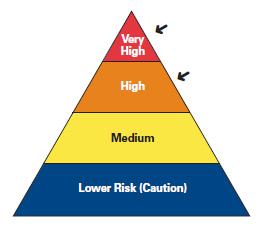
Healthcare Workplaces Classified as Very High or High Exposure Risk for Pandemic Influenza
What to do to protect workers
If your workplace requires your workers to have contact with people who are known or suspected to be infected with the pandemic virus, there are important practices to reduce the risk of infection and to protect your workers.
Very high exposure risk occupations are those with high potential for exposure to known or suspected sources of pandemic influenza during specific medical or laboratory procedures:
- Healthcare workers performing aerosol generating procedures on known or suspected pandemic patients.
- Healthcare or laboratory personnel collecting or handling specimens from known or suspected pandemic patients.
High exposure risk occupations are those with high potential for exposure to known or suspected sources of pandemic virus:
- Healthcare delivery and support staff exposed to known or suspected pandemic patients.
- Staff providing medical transport of known or suspected influenza patients in enclosed vehicles.
- Staff performing autopsies on known or suspected pandemic patients.
 Engineering Controls
Engineering Controls
These types of controls involve making changes to the work environment to reduce work-related hazards.
- Healthcare facilities equipped with isolation rooms need to use them when performing aerosol-generating procedures for patients with known or suspected pandemic influenza.
- Only Biosafety Level 2 or 3 laboratory facilities (depending on the procedures performed) should process specimens from known or suspected pandemic patients.
- Where possible, install physical barriers such as clear plastic sneeze guards in reception or intake areas.
- Review and increase housekeeping vigilance to control the spread of infectious agents through additional cleaning of contact surfaces, and through prompt and thorough waste disposal.
Work Practices
Train workers in work practices such as hand hygiene, facility hygiene, and other infection control measures. For details see Pandemic Influenza Preparedness and Response Guidance for Healthcare Workers and Healthcare Employers at www.osha.gov/Publications/3328-05-2007-English.html.
- Provide conveniently located masks, tissues and alcohol-based hand rubs for waiting areas and patient evaluation areas to reduce the spread of infection.
Administrative Controls
Healthcare facilities need to follow existing guidelines and facility standards of practice for identifying and isolating infected individuals and for protecting workers. Develop and implement policies that reduce exposures.
- Post signs requesting patients and family members to immediately report symptoms of respiratory illness on arrival at the facility and use disposable tissues to cover the nose and mouth when coughing.
Personal Protective Equipment (PPE)
For those who work closely (within 6 feet) with people known or suspected to be infected with pandemic influenza:
- Use NIOSH-certified respirators that are N95 or higher. When both fluid protection (e.g., blood splashes) and respiratory protection are needed, use a "surgical N95" respirator that has been certified by NIOSH and cleared by the FDA.
- Consider NIOSH-certified elastomeric respirators (e.g., cartridge respirators) for essential workers who may have to decontaminate and reuse respirators in the event that there is a shortage of disposable respirators.
- Consider NIOSH-certified powered air-purifying respirators for essential workers who may have to decontaminate and reuse respirators, wear respirators for prolonged periods of time, be exposed to high-risk procedures, or work in high-risk environments. Loose-fitting hooded powered air purifying respirators have the additional advantage of not requiring fit testing.
- Be fit tested and trained in the proper use and care of a respirator. (www.osha.gov/SLTC/respiratoryprotection/index.html).
- Use gloves made of latex, vinyl, nitrile, or other synthetic materials as appropriate, when there is contact with blood and other bodily fluids, including respiratory secretions.
- Wear an isolation gown when it is anticipated that soiling of clothes or uniform with blood or other bodily fluids, including respiratory secretions, may occur.
- Use eye and face protection if sprays or splatters of infectious material are likely. Goggles should be worn during the performance of aerosol-generating procedures. Use of a full face shield in front of a respirator may also prevent bulk contamination of the respirator.
Education and training material need to be easily understood and available in the appropriate language and literacy level for all workers. Employers must have a respiratory protection program that complies with OSHA's Respiratory Protection Standard at 29 CFR 1910.134, including worker fit testing, medical evaluation, and training in the proper use and care of a respirator.
For more information, please refer to OSHA Publication No. 3328, Pandemic Influenza Preparedness and Response Guidance for Healthcare Workers and Healthcare Employers, which can be accessed at: www.osha.gov. Additional information can be found at www.pandemicflu.gov.
This is one in a series of informational fact sheets highlighting OSHA programs, policies or standards. It does not impose any new compliance requirements. For a comprehensive list of compliance requirements of OSHA standards or regulations, refer to Title 29 of the Code of Federal Regulations. This information will be made available to sensory impaired individuals upon request. The voice phone is (202) 693-1999; teletypewriter (TTY) number: (877) 889-5627.
For more complete information:
 |
Occupational
Safety and Health
Administration |
U.S. Department of Labor
www.osha.gov (800) 321-OSHA
DSG 5/2009
|


 Engineering Controls
Engineering Controls